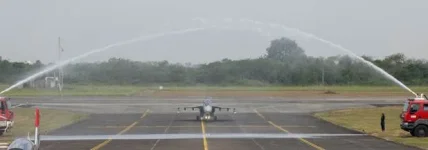
The indigenously developed Tejas Light Combat Aircraft (LCA) Mk-1 successfully demonstrated its combat capabilities during Tarang Shakti 2024, the largest multilateral air combat exercise hosted by India.
Air Chief Marshal VR Chaudhari, the Indian Air Force (IAF) chief, praised the Tejas' performance, stating that it proved that "size does not matter" as it effectively executed various missions alongside larger, more modern fighter jets from around the world.
The Tejas participated as part of both the "blue force" (friendly) and "red force" (hostile) teams, showcasing its versatility in realistic combat scenarios. The chiefs of the French and German air forces even flew in the LCA Mk-1, highlighting the international recognition of its capabilities.
This exercise marks the first time the LCA Mk-1 has participated in such large force engagements, and its success has boosted confidence in India's self-reliance campaign in the defense sector. The IAF plans to increase the use of the Tejas in future air combat drills both domestically and internationally.
Challenges and Delays in LCA Mk-1A Program
While the LCA Mk-1 has proven its worth, the advanced variant, the LCA Mk-1A, is facing delays. The IAF chief acknowledged that if sufficient numbers of LCA Mk-1As were available, they would have participated in Tarang Shakti. The first aircraft, originally scheduled for delivery in March 2024, is now expected in November 2024.The IAF has expressed concerns about the delays in the LCA Mk-1A program and their potential impact on the air force's combat effectiveness. The main reasons for the delays include a delay in the supply of F404 engines and pending certification of new systems in the aircraft.
Despite these challenges, the defense ministry is considering awarding Hindustan Aeronautics Limited (HAL) a contract for an additional 97 LCA Mk-1As to strengthen the air force's capabilities.
Tarang Shakti Showcases India's Indigenous Military Capabilities
Exercise Tarang Shakti has provided India with an opportunity to showcase its indigenous military capabilities to the world. In addition to the Tejas, other domestically developed platforms such as the Prachand light combat helicopter and Dhruv advanced light helicopter also participated in the exercise.The drills involved a wide range of missions, including within and beyond visual range combat, large force engagements, air mobility operations, and combat search and rescue.
Tarang Shakti follows other recent major exercises conducted by the IAF, such as Gagan Shakti 24 and Vayu Shakti 24, further demonstrating India's commitment to strengthening its air power.

